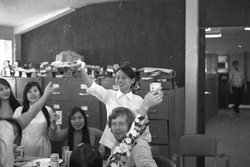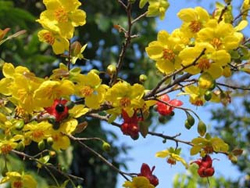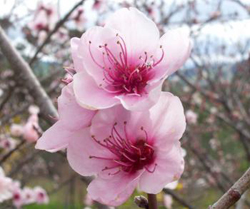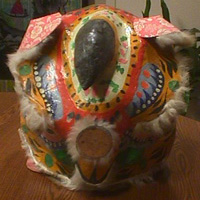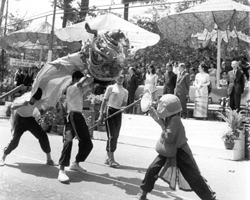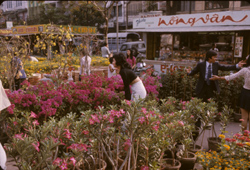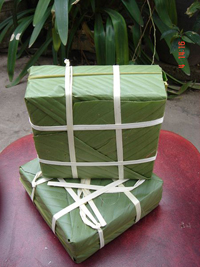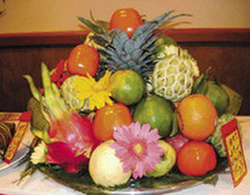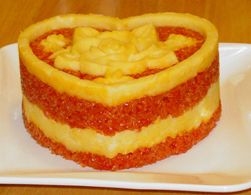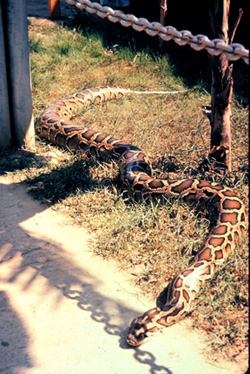Let's Celebrate Tết
-
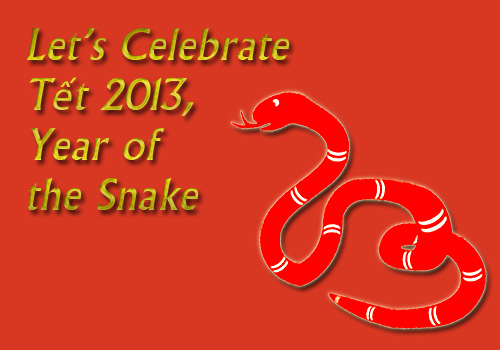
-
What is Tết?
Tết is Vietnam’s biggest holiday. For many countries it is the celebration of the Lunar New Year, but for the Vietnamese Tết is also the time to celebrate everyone’s birthday, the beginning of spring and even Christmas. It is a time for family, food, celebration and hope for a peaceful and prosperous New Year. Tết is officially a three day holiday, but many Vietnamese celebrate for up to seven days. It occurs every year between late January and early February, depending on the phase of the moon.
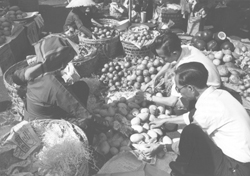
South Vietnam's 1969 TET Celebration - Delicacies - Mangoes, watermelon and other fruits were especially abundant at Tet. Food and fruit were on sale throughout South Vietnam
(Douglas Pike Photograph Collection [VA000727])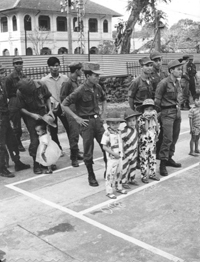
Division Headquarters personnel and dependents preparing to receive Tet gifts. How do you like the colorful getups on the children? 1965 My Tho Tet 7th Division
(Edward P. Metzner Collection [VA034417]) -
The Three Days of Tết
Tết has many traditions and customs. In preparation for Tết everyone gets a haircut, new clothes, cleans their house from top to bottom and settles any debt so that they can begin the new year with a fresh start. Tết starts on New Year’s Eve when giao thừa is celebrated: a ceremony where a family thanks the outgoing spirits who are on their way to heaven, welcomes the new year and invites the spirits of their ancestors to their homes to help them celebrate.
On the first day of Tết everyone spends time with their families, relatives visit from all over and even the ancestors are included in the festivities. The first visitor to the house is very important because they can influence the family’s fortunes for the entire year; if the visitor is wealthy the family will be prosperous, if they have good luck so will the family. Consequently, there is a lot of protocol involved with visiting a family during the first day of Tết. The second day of Tết is reserved for visiting special guests and close friends and on the third day everyone visits teachers and important business associates.
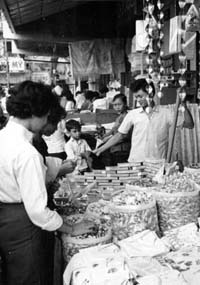
Sergeant Lien at Saigon Market shopping for Tet for Marine Children
(Lee Baker Collection [VA038176])See also: -
Tết Traditions
During Tết it is believed that all of the spirits who guard the house leave earth to go to heaven and report their observations for the year to the Emperor of Jade. At the same time evil spirits are allowed to roam the earth, so many traditions and decorations of Tết are meant to scare away evil spirits and protect the family.
The cây nếu, a decorated bamboo pole, is placed outside a house and covered with symbols, colorful streamers and other items meant to help the good spirits and scare away the evil ones. The apricot tree is a symbol of protection and is feared by evil spirits, so many families have blooming apricot branches outside their doors and in their houses. Firecrackers, drums, gongs and noise also scare away evil spirits, so New Years can be a noisy time in Vietnam.
The unicorn and dragon dance is often preformed on New Year’s Eve. The unicorn symbolizes kindness and wisdom. People leave money attached to their bamboo poles, cây nếu, or other areas outside their houses to entice the unicorn. If the unicorn takes the offering, the family or business will have good luck in the coming year.
Many Tết traditions are also tied to good luck. Red is the color of good luck and happiness, so red decorations appear everywhere during this time, especially red envelopes. On the first day of Tết children are given a red envelope with money inside lì xì, which they are allowed to spend on whatever they want. Peach blossoms and kumquats are symbols of luck and good fortune as well so many people will buy a kumquat tree and blooming peach limbs from the booming flower markets that spring up just before Tết to decorate their houses.
-
Tết Traditions (continued)
Traditional greetings during Tết involve wishing each other good fortune, good luck or a new addition to the family. Almost all Tết greetings are tied to these themes.
Chúc ông năm nay mua máy bán đất, thiế tại như nước - I wish that your business may prosper with the new year and that money flows into your house like water.Cũng chúc tân xuân – Many wishes for the new spring
On the final day of Tết the family has a ceremony where they thank the ancestors for participating in their celebration and then burn symbolic paper clothes and money for the ancestors to use in heaven.
-
Traditional Food of Tết
Food is a very important part of Tết and families will spend days making elaborate meals to celebrate. Many of these foods are only served during Tết.
- Bánh Chưng - This dish is made of rice, beans and pork and is wrapped in là đồng leaves making a square green package.
- Mang – a soup of boiled bamboo shoots and fried pork
- Xỏi Gác – orange sticky rice
- Five fruit tray – usually contains banana, orange, kumquat, pomelo, and finger citron
-
Year of the Snake
The Vietnamese calendar adds up to a sixty year cycle. Within the cycle, each year is tied to a major element, wood, fire, earth, metal and water and also one of twelve animals or zodiac signs – Rat, Buffalo, Tiger, Cat , Dragon, Snake, Horse, Goat, Monkey, Chicken, Dog or Pig. Each animal and element has its own individual characteristics.
2013 is the Year of the Snake and is believed to be a year of peace and prosperity. The snake is an important part of life in Vietnam. People born in the Year of the Snake are endowed with wisdom and excel in finding solutions to problems. They are usually successful in life and lucky with money.
Vietnam Center & Sam Johnson Vietnam Archive
-
Address
Texas Tech University, Box 41041, Lubbock, TX 79409 -
Phone
(806)742-9010 -
Email
vnca@ttu.edu

